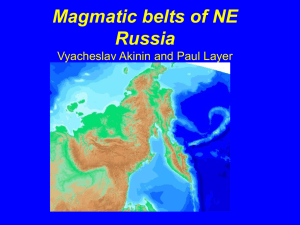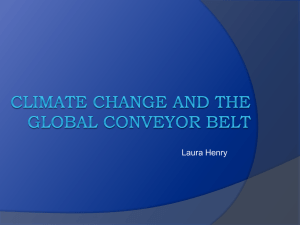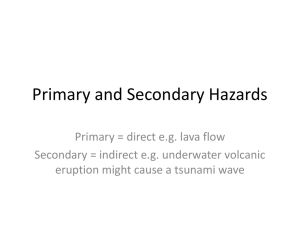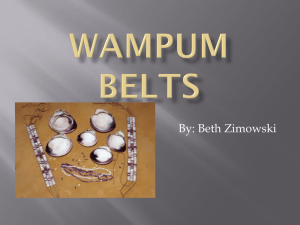Lecture 1: Climate and Geology of the Skeena River
advertisement
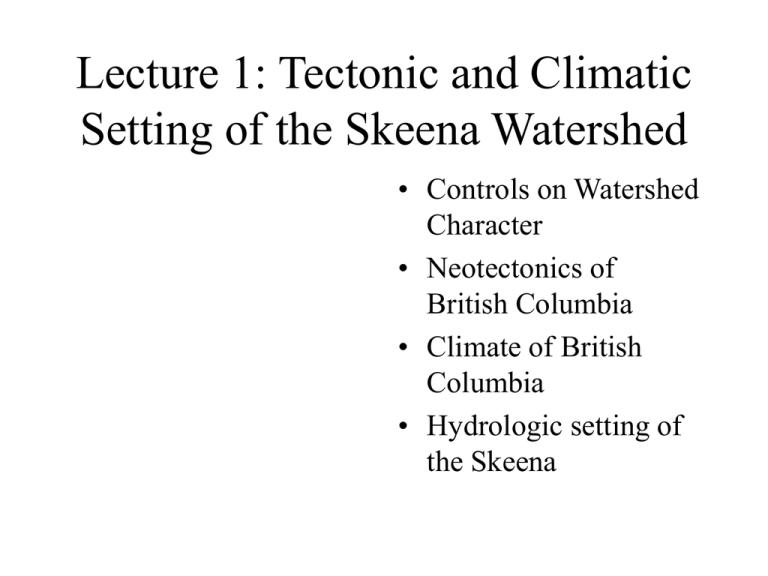
Lecture 1: Tectonic and Climatic Setting of the Skeena Watershed • Controls on Watershed Character • Neotectonics of British Columbia • Climate of British Columbia • Hydrologic setting of the Skeena Watershed Controls • Dependent versus independent variables Tectonic Setting • Tectonics as a fundamental control on watershed rock type • Tectonic control on style and rates of uplift • Tectonic influences on regional and local climate The Hydrologic Cycle • Five Morphogeologic Belts in Canadian Cordillera • Each belt with distinctive rock types, landforms • Belts reflect 750 my of activity at North American Plate margin • Foreland Belt: Rocky, Mackenzie and Franklin Mountains • Precambrian and Paleozoic sedimentary rocks • Western margin of North America until Jurassic • Folded and thrust eastward in late Jurassic-Early Tertiary • Omineca Belt: Purcell, Selkirk, Monashee, Cariboo, Omineca, Cassiar and Selwyn Mountains • Sedimentary, volcanic and granitic rocks • Accreted terranes • Granitic/volcanic rocks of arc • Deforemed in late Jurassic-early Teritary • Intermontane Belt: Interiar, Stikine and Yukon Plateaus and Skeena Mountains • Volcanic, sedimentary and granitic rocks • Accreted terranes (Stikine) • Thick sedimentary deposites of Mesozoic-early Teritiary age (Bowser Basin) • Extensional basins in Mesozoic and Cenozoic • Volcanic arcs • Coast Belt: Coast and Cascade Mountains • Granitic and volcanic rocks • Jurassic through presentday volcanic arcs • Large strike-slip or transform faults • Local accreted terranes • Insular Belt: Insular Mountains, Saint Elias Ranges, coastal depressions, islands, continental shelf and slope • Volcanic, sedimentary and granitic rocks • Subduction zone accretion • Volcanic arcs • Large strike-slip faults Skeena Watershed: • Coast Belt and Intermontane Belt • High rates of uplift in Coast Belt/Coast Mountains • Intermontane Belt is extensional (pull-apart) with broad uplift Coast Mountains • Extensive range in coastal BC • Uplift began 10 MA at 220m/MA •Accelerated to 400+m/MA 2.5 MA •Causes of accelerated uplift due to glacial exhumation? •Dominant influence on climate during the Pleistocene and Holocene Cordilleran Ice Sheet QuickTime™ and a Photo - JPEG decompressor are needed to see this picture. • Extensive Pleistocene ice sheet that coveren most of North America • Multiple expansions and retreats of ice sheets • Significant, but disputed impacts in British Columbia Maximum extent of continental glaciation 18,000 years ago Feedbacks • Climate controls glacier mass balance, temperature, size, thermal regime, movement and geomorphic activity • Glaciers influence albedo, surface energy balance, atmospheric and oceanic circulation • Elevation controls rates of accumulation and ablation in glaciers • Uplift controls rate of accumulation and rate of erosion Mass Balance in Glaciers • Mass balance is a function of: – Inputs (accumulation) – Throughputs (transport) – Outputs (ablation) • Links climate change, uplift and glacial variation Mass balance components: • ablation • accumulation • mass flux Phases of Ice Flow QuickTime™ and a Photo - JPEG decompressor are needed to see this picture. • Ice Expansion: controlled by local accumulation and topography • Maximum: uncontrolled by topography • Late: topographic control during retreat Historical understanding of last glacial maxima in BC From: McCuaig and Roberts, 2002 Climate • Climate in the Skeena Watershed a function of tectonic setting and its interactions with ocean/atmospheric circulation patterns • Multiple time scales of variation, including seasonal, interannual, decadal…. QuickTime™ and a TIFF (Uncompressed) decompressor are needed to see this picture. El Niño and Pacific Decadal Oscillations • Evidence for fluctuations in sea surface temps at various timescales. • El Niño events vary from 6 -18 months • Pacific Decadal Oscillation events vary from 20-30 years Modes of Pacific climate variability From: Mantua et al. 1997. Bull. Amer. Soc. 78: 1069-1079 Intensity and Location of the Aleutian Low From: Gargett: Fish. Oceanogr. 6: 109-117 Gulf of Alaska Zooplankton Biomass 1956-1962 From: Brodeur and Ware (1992) Fish. Oceanogr. 1: 32-38 1980-1989 standard deviations PDO turns sharply negative in mid 1998 3 0 -3 1900 1920 1940 1960 1980 2000 Climate Change in British Columbia According to Ministry of Water, Land and Air •Average annual temperature warmed by 0.6ºC on the coast, 1.1ºC in the interior, and 1.7ºC in northern BC. •Night-time temperatures increased across most of BC in spring and summer. • Precipitation increased in southern BC by 2 to 4 percent per decade. • Lakes and rivers become free of ice earlier in the spring. • Sea surface temperatures increased by 0.9ºC to 1.8ºC along the BC coast. • Sea level rose by 4 to 12 centimetres along most of the BC coast. •Two large BC glaciers retreated by more than a kilometre each. • The Fraser River discharges more of its total annual flow earlier in the year. •Water in the Fraser River is warmer in summer. •More heat energy is available for plant and insect growth. Impacted by Summer Rearing Habitat Steelhead and Chinook




